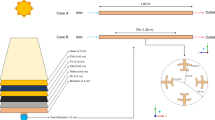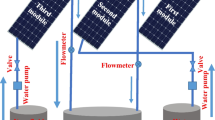Abstract
Current work delves into enhancing the productivity of a photovoltaic (PV) unit by incorporating a thermoelectric generator (TEG). The cooling mechanism employs a triangular-shaped duct with a ferrofluid, and magnetic force is employed to augment the cooling efficiency. Additionally, the model accounts for the impact of dust on the system's productivity. The efficiency components, namely ηth (thermal), ηTE (thermoelectric), and ηPV (electrical PV), have been evaluated across different ranges of ϕ (nanoparticle concentration), Ha (Hartmann number), and Vin (inlet velocity). These results have been obtained through rigorous numerical simulations, with a comprehensive validation test to ensure their accuracy and reliability. When accounting for the presence of dust particles, we observe a reduction in ηth, ηTE, and ηPV by approximately 3.98, 6.96, and 9.46%, respectively. Conversely, in the presence of dust, as Ha is increased, we note a notable enhancement in ηth, ηTE, and ηPV, showing an increase of around 6.68, 19.16, and 0.69% respectively. It is worth mentioning that the increase in ηPV's enhancement diminishes by about 4.12% under the influence of dust. When Vin is set at 0.078, we observe significant enhancements in ηth, ηTE, and ηPV, amounting to approximately 7.29, 20.25, and 0.72%, respectively, as Ha increases. However, it is worth noting that the influence of Ha on both ηth and ηTE diminishes, showing a decrease of about 8.25 and 4.48%, respectively, when Vin is set to 0.17 m/s. On the other hand, an increase in Vin leads to an intensified effect on ηth, ηTE, and ηPV, with enhancements of around 10.19, 29.14, and 1%, respectively, under the condition of Ha = 0. Furthermore, with the rise of Ha, the influence of Vin on ηPV experiences an increment of about 0.5%, while its impact on ηth diminishes by approximately 6%. Introducing nanoparticles can bolster the thermal characteristics of the ferrofluid, leading to significant enhancements in performance, particularly in ηTE. However, it is worth noting that the improvements in ηth, ηTE, and ηPV due to the addition of nanoparticles decrease by about 13.37, 9.91, and 4.78%, respectively, with the increase of Vin, especially in the absence of Ha. Additionally, the uniformity experiences substantial improvements of approximately 22.54 and 31.25% with the augmentation of Ha, observed at Vin values of 0.078 and 0.17, respectively.








Similar content being viewed by others
Data availability statement
No datasets were generated or analyzed during the current study.
References
Tomar V, Norton B, Tiwari GN. A novel approach towards investigating the performance of different PVT configurations integrated on test cells: an experimental study. Renew Energy. 2019;137:93–108. https://doi.org/10.1016/j.renene.2017.11.020.
Lu C, Zhou H, Li L, Yang A, Xu C, Ou Z, Tian F. Split-core magnetoelectric current sensor and wireless current measurement application. Measure J Int Measure Confederation. 2022;188. https://doi.org/10.1016/j.measurement.2021.110527.
Chu Y-M, Abu-Hamdeh NH, Ben-Beya B, Hajizadeh MR, Li Z, Bach Q-V, Nanoparticle enhanced PCM exergy loss and thermal behavior by means of FVM. J Mol Liquids 2020;320(Part B):114457. https://doi.org/10.1016/j.molliq.2020.114457.
Li R, Xu D, Tian H, Zhu Y. Multi-objective study and optimization of a solar-boosted geothermal flash cycle integrated into an innovative combined power and desalinated water production process: Application of a case study. Energy. 2023;282: 128706. https://doi.org/10.1016/j.energy.2023.128706.
Saqib M, Shafie S, Khan I, Chu Y-M. Kottakkaran Sooppy Nisar, Symmetric MHD channel flow of nonlocal fractional model of BTF containing hybrid nanoparticles. Symmetry. 2020;12(4):663. https://doi.org/10.3390/sym12040663.
Alsheikhy AA. A fire detection algorithm using convolutional neural network. King Abdulaziz J Eng Sci. 2022;32(2):39–55. https://doi.org/10.4197/Eng.32-2.3.
Almitani KH, Abd EA, Elamin MA. Improvement of electrical performance of photovoltaic cell with incorporating nanofluid flow as cooling system. Alexandria Eng J. 2023;76:689–700. https://doi.org/10.1016/j.aej.2023.06.068.
Wahab A, Khan MAZ, Hassan A. Impact of graphene nanofluid and phase change material on hybrid photovoltaic thermal system: Exergy analysis. J Cleaner Prod. 2020;277: 123370. https://doi.org/10.1016/j.jclepro.2020.123370.
Sheikholeslami M. Numerical investigation for concentrated Photovoltaic solar system in existence of paraffin equipped with MWCNT nanoparticles. Sustain Cities Soc. 2023;99: 104901. https://doi.org/10.1016/j.scs.2023.104901.
Nasrin R, Rahim N, Fayaz H, Hasanuzzaman M, Water/MWCNT nanofluid based cooling system of PVT: experimental and numerical research. Renew Energy 2018;121:286e300
Khalili Z, Sheikholeslami M. Analyzing the effect of confined jet impingement on efficiency of photovoltaic thermal solar unit equipped with thermoelectric generator in existence of hybrid nanofluid. J Clean Prod. 2023;406(20): 137063. https://doi.org/10.1016/j.jclepro.2023.137063.
Madas SR, Narayanan R, Gudimetla P. Numerical investigation on the optimum performance output of photovoltaic thermal (PVT) systems using nano-copper oxide (CuO) coolant. Sol Energy. 2023;255:222–35. https://doi.org/10.1016/j.solener.2023.02.035.
Makki A, Omer S, Su Y, Sabir H, Numerical investigation of heat pipe-based photovoltaic-thermoelectric generator (HP-PV/TEG) hybrid system. Energy Convers. Manag. 2016;112:274e287.
Sheikholeslami M, Khalili Z, Momayez L Efficiency improvement of ternary nanofluid within a solar Photovoltaic unit combined with thermoelectric considering environmental analysis. Environ Technol Innov 2023;32:103315. https://doi.org/10.1016/j.eti.2023.103315.
Li D, Xuan Y, Li Q, Hong H, Exergy and energy analysis of photovoltaicthermoelectric hybrid systems. Energy 2017;126:343e351.
Sheikholeslami M, Khalili Z. Investigation of solar Photovoltaic cell utilizing hybrid nanofluid confined jet and helical fins for improving electrical efficiency in existence of thermoelectric module. Appl Therm Eng. 2023;234(5): 121329. https://doi.org/10.1016/j.applthermaleng.2023.121329.
Sheikholeslami M, Khalili Z, Scardi P, Ataollahi N. Concentrated solar photovoltaic cell equipped with thermoelectric layer in presence of nanofluid flow within porous heat sink: impact of dust accumulation. Sustain Cities Soc. 2023;98: 104866. https://doi.org/10.1016/j.scs.2023.104866.
Lekbir A, Hassani S, Ghani MRA, Gan CK, Mekhilef S, Saidur R. Improved energy conversion performance of a novel design of concentrated photovoltaic system combined with thermoelectric generator with advance cooling system. Energy Convers Manage. 2018;177:19–29. https://doi.org/10.1016/j.enconman.2018.09.053.
Khalili Z, Sheikholeslami M. Numerical modeling for efficiency of solar cell module combined with TEG involving Fe3O4-water nanofluid utilizing MHD. J Magn Magn Mater. 2023;580: 170950. https://doi.org/10.1016/j.jmmm.2023.170950.
Almitan KH, Abu-Hamdeh NH, Abusorrah AM, AL-bonsrulah HAZ, Elamin AEAMA, Simulation of latent heat thermal storage evaluation utilizing NEPCM for new ventilation system for building. J Build Eng 2023. https://doi.org/10.1016/j.jobe.2023.107288
Tian H, Li R, Salah B, Thinh P. Bi-objective optimization and environmental assessment of SOFC-based cogeneration system: performance evaluation with various organic fluids. Process Saf Environ Prot. 2023;178:311–30. https://doi.org/10.1016/j.psep.2023.07.040.
Li J, Alawee WH, Rawa MJH, Dhahad HA, Chu Y-M, Issakhov A, Abu-Hamdeh NH, Hajizadeh MR, Heat recovery application of nanomaterial with existence of turbulator. J Mol Liquids 2021;326:115268. https://doi.org/10.1016/j.molliq.2020.115268
Almaneey S, Gari AA. Natural convection in a vertical annulus enclosure with longitudinal fins. King Abdulaziz J Eng Sci. 2022;32(2):13–37. https://doi.org/10.4197/Eng.32-2.2.
Zhang J, Zhong A, Huang G, Yang M, Li D, Teng, M.,... Han, D. Enhanced efficiency with CDCA co-adsorption for dye-sensitized solar cells based on metallosalophen complexes. Sol Energy. 2020;209:316–24. https://doi.org/10.1016/j.solener.2020.08.096.
Sheikholeslami M, Ellahi R. Three dimensional mesoscopic simulation of magnetic field effect on natural convection of nanofluid. Int J Heat Mass Transf. 2015;89:799–808. https://doi.org/10.1016/j.ijheatmasstransfer.2015.05.110.
Zhao C, Cheung CF, Xu P. High-efficiency sub-microscale uncertainty measurement method using pattern recognition. ISA Trans. 2020;101:503–14. https://doi.org/10.1016/j.isatra.2020.01.038.
Manjunatha S, Puneeth V, Gireesha B, Chamkha AJ. Theoretical study of convective heat transfer in ternary nanofluid flowing past a stretching sheet. J Appl Comput Mech. 2022;8(4):1279–86. https://doi.org/10.22055/jacm.2021.37698.3067.
Sun L, Liang T, Zhang C, Chen J. The rheological performance of shear-thickening fluids based on carbon fiber and silica nanocomposite. Phys Fluids. 2023;35(3):32002. https://doi.org/10.1063/5.0138294.
Basha H, Sivaraj R. Stability analysis of casson nanofluid flow over an extending/contracting wedge and stagnation point. J Appl Comput Mech. 2022;8(2):566–79. https://doi.org/10.22055/jacm.2020.32618.2045.
Rothan YA, Influence of magnetic force on physical treatment of nanofluid laminar flow developing numerical approach. Int J Mod Phys B 2022. https://doi.org/10.1142/S0217979223501345
Liao K, Lu D, Wang M, Yang J. A low-pass virtual filter for output power smoothing of wind energy conversion systems. IEEE Trans Industr Electron. 2022;69(12):12874–85. https://doi.org/10.1109/TIE.2021.3139177.
Babazadeh H, Muhammad T, Shakeriaski F, Ramzan M, Hajizadeh MR, Nanomaterial between two plates which are squeezed with impose magnetic force. J Thermal Anal Calorimetry 2020; https://doi.org/10.1007/s10973-020-09619-6
Khalili Z, Sheikholeslami M. Investigation of innovative cooling system for photovoltaic solar unit in existence of thermoelectric layer utilizing hybrid nanomaterial and Y-shaped fins. Sustain Cities Soc. 2023;93: 104543. https://doi.org/10.1016/j.scs.2023.104543.
Sheikholeslami M, Khalili Z. Investigation of solar Photovoltaic-Thermoelectric system for building unit in presence of helical tapes and jet impingement of hybrid nanomaterial. J Build Eng. 2023;74(1): 106871. https://doi.org/10.1016/j.jobe.2023.106871.
Hegazy AA. Effect of dust accumulation on solar transmittance through glass covers of plate-type collectors. Renew Energy. 2001;22(4):525–40.
Khalili Z, Sheikholeslami M. Simulation of photovoltaic thermal solar system with new technique for improving electrical performance. J Therm Anal Calorim. 2023. https://doi.org/10.1007/s10973-023-12526-1.
Acknowledgements
The authors extend their appreciation to the Deputyship for Research and Innovation, Ministry of Education in Saudi Arabia, for funding this research work through the project number ISP23-60
Author information
Authors and Affiliations
Corresponding author
Ethics declarations
Conflict of interest
There is no conflict of interest regarding to this manuscript.
Additional information
Publisher's Note
Springer Nature remains neutral with regard to jurisdictional claims in published maps and institutional affiliations.
Rights and permissions
Springer Nature or its licensor (e.g. a society or other partner) holds exclusive rights to this article under a publishing agreement with the author(s) or other rightsholder(s); author self-archiving of the accepted manuscript version of this article is solely governed by the terms of such publishing agreement and applicable law.
About this article
Cite this article
Almarashi, A., Hamali, W., Mechai, I. et al. Photovoltaic thermal solar system in presence of nanofluid cooling analyzing environmental parameter in existence of TEG module. J Therm Anal Calorim 149, 2739–2747 (2024). https://doi.org/10.1007/s10973-023-12827-5
Received:
Accepted:
Published:
Issue Date:
DOI: https://doi.org/10.1007/s10973-023-12827-5




